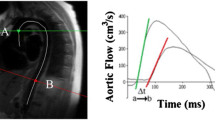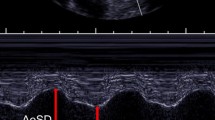Abstract
Background
Obesity may be associated with early vascular changes. The current study was designed to assess the relationship between obesity and aortic stiffness in two populations, one aged 18–40 years and one aged 41–64 years.
Methods
The study complied 121 subjects, all of them underwent a physical examination, transthoracic echocardiography and blood pressure measurement. Aortic stiffness index (β) was evaluated from aortic diameter and blood pressure data.
Results
β was higher in obese subjects both in the young (4.26 ± 1.57 vs. 6.88 ± 5.96, P < 0.05) and old patient populations (7.13 ± 4.99 vs. 14.89 ± 14.64, P < 0.05). Systolic (SD) aortic diameters (in mm) were enlarged in obese young patients (25.7 ± 2.8 vs. 27.1 ± 2.5, P < 0.05) and obese old subjects (28.0 ± 3.0 vs. 30.3 ± 3.3, P < 0.05). Diastolic (DD) aortic diameter (in mm) showed similar tendency in youngs (22.8 ± 2.9 vs. 24.9 ± 2.5, P < 0.05) and old subjects (25.9 ± 2.7 vs. 28.0 ± 3.1, P < 0.05).
Conclusions
Aortic stiffness is higher in young obese patients and similar to older subjects without obesity. Both SD and DD are increasing with age, but subjects within similar age group have larger SD and DD suggesting early vascular remodelling in obesity.



Similar content being viewed by others
References
Kurth T, Gaziano JM, Berger K et al (2002) Body mass index and the risk of stroke in men. Arch Intern Med 162:2557–2562
Wilson PW, D’Agostino RB, Sullivan L et al (2002) Overweight and obesity as determinants of cardiovascular risk: the Framingham experience. Arch Intern Med 162:1867–1872
Sutton-Tyrrell K, Newman A, Simonsick EM et al (2001) Aortic stiffness is associated with visceral adiposity in older adults enrolled in the study of health, aging, and body composition. Hypertension 38:429–433
Stefanadis C, Stratos C, Boudoulas H, Kourouklis C, Toutouzas P (1990) Distensibility of the ascending aorta: comparison of invasive and non-invasive techniques in healthy men and in men with coronary artery disease. Eur Heart J 11:990–996
Nemes A, Caliskan K, Geleijnse ML et al (2007) Alterations in aortic elasticity in noncompaction cardiomyopathy. Int J Cardiovasc Imag (in press)
WHO. (1998) Obesity: preventing and managing the global epidemic: report of a WHO consultation of obesity, Geneva, 1997, World Health Organisation. Obes Res 6:51S–210S
Lakka HM, Laaksonen DE, Lakka TA et al (2002) The metabolic syndrome and total and cardiovascular disease mortality in middle-aged men. JAMA 288:2709–2716
Nemes A, Galema TW, Geleijnse ML et al (2007) Aortic valve replacement for aortic stenosis is associated with improved aortic distensibility at long-term follow-up. Am Heart J 153:147–151
Henry WL, DeMaria A, Gramiak R et al (1980) Report of the American Society of Echocardiography Committee on Nomenclature and Standards in Two-dimensional Echocardiography. Circulation 62:212–217
Pannier B, Guerin AP, Marchais SJ et al (2005) Stiffness of capacitive and conduit arteries: prognostic significance for end-stage renal disease patients. Hypertension 45:592–596
Blacher J, Safar ME, Pannier B et al (2002) Prognostic significance of arterial stiffness measurements in end-stage renal disease patients. Curr Opin Nephrol Hypertens 11:629–634
Nemes A, Forster T, Csanady M, (2007) Impaired coronary flow velocity reserve and aortic distensibility in patients with untreated hypercholesterolemia—an echocardiographic study. Int J Cardiovasc Imaging 23:15–23
Nemes A, Forster T, Csanady M et al (2004) Indices of aortic distensibility and coronary flow velocity reserve in patients with different grades of aortic atherosclerosis. Int J Cardiovasc Imaging 20:271–277
Danias PG, Tritos NA, Stuber M et al (2003) Comparison of aortic elasticity determined by cardiovascular magnetic resonance imaging in obese versus lean adults. Am J Cardiol 91:195–199
Wildman RP, Mackey RH, Bostom A et al (2003) Measures of obesity are associated with vascular stiffness in young and older adults. Hypertension 42:468–473
Mackey RH, Sutton-Tyrrell K, Vaitkevicius PV et al (2002) Correlates of aortic stiffness in elderly individuals: a subgroup of the Cardiovascular Health Study. Am J Hypertens 15:16–23
Wildman RP, Farhat GN, Patel AS et al (2005) Weight change is associated with change in arterial stiffness among healthy young adults. Hypertension 45:187–192
Brunzell JD, Hokanson JE (1999) Dyslipidemia of central obesity and insulin resistance. Diabetes Care 22(Suppl 3):C10–C13
Stenvinkel P, Bolinder J, Alvestrand A (1992) Effects of insulin on renal haemodynamics and the proximal and distal tubular sodium handling in healthy subjects. Diabetologia 35:1042–1048
Young JB (1988) Effect of experimental hyperinsulinemia on sympathetic nervous system activity in the rat. Life Sci 43:193–200
Ulrich P, Cerami A (2001) Protein glycation, diabetes, and aging. Recent Prog Horm Res 56:1–21
DeFronzo RA, Ferrannini E. (1991) Insulin resistance. A multifaceted syndrome responsible for NIDDM, obesity, hypertension, dyslipidemia, and atherosclerotic cardiovascular disease. Diabetes Care 14:173–194
Kahn BB, Flier JS (2000) Obesity and insulin resistance. J Clin Invest 106:473–481
Arcaro G, Cretti A, Balzano S et al (2002) Insulin causes endothelial dysfunction in humans: sites and mechanisms. Circulation 105:576–582
Egan BM, Lu G, Greene EL (1999) Vascular effects of non-esterified fatty acids: implications for the cardiovascular risk factor cluster. Prostaglandins Leukot Essent Fatty Acids 60:411–420
Weyer C, Yudkin JS, Stehouwer CD et al (2002) Humoral markers of inflammation and endothelial dysfunction in relation to adiposity and in vivo insulin action in Pima Indians. Atherosclerosis 161:233–242
Visser M, Bouter LM, McQuillan GM et al (1999) Elevated C-reactive protein levels in overweight and obese adults. JAMA 282:2131–2135
Schutte R, Huisman HW, Schutte AE et al (2005) Leptin is independently associated with systolic blood pressure, pulse pressure and arterial compliance in hypertensive African women with increased adiposity: the POWIRS study. J Hum Hypertens 19:535–541
Author information
Authors and Affiliations
Corresponding author
Rights and permissions
About this article
Cite this article
Nemes, A., Gavallér, H., Csajbók, É. et al. Obesity is associated with aortic enlargement and increased stiffness: an echocardiographic study. Int J Cardiovasc Imaging 24, 165–171 (2008). https://doi.org/10.1007/s10554-007-9248-2
Received:
Accepted:
Published:
Issue Date:
DOI: https://doi.org/10.1007/s10554-007-9248-2




